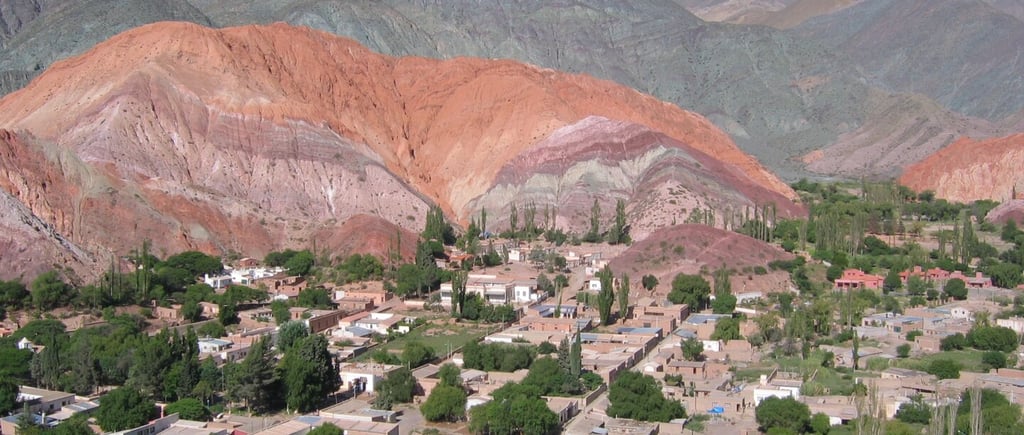A Terracotta Route Through Northern Argentina: From Silence to Song
Travel slowly through Salta and Jujuy, where ancient valleys, painted hills, and sacred silences shape a journey meant to be felt. A poetic route across Argentina’s northern soul.
PLACESTRAVELNORTHERN ARGENTINA
Gabriela Arellano
6/3/20254 min read


The North of Argentina is not just one place—it's a sprawling land where time slows down, and every step feels like a journey into the past. A winding road that weaves through stone and history, where each bend reveals a new note in a song the land has been singing for centuries.
This is not a journey guided by checklists, but one shaped by presence. By breath. By the kind of silence that whispers the ancient secrets of the hearth.
🌿Start in Salta: Echoes and Terracotta Hues
Let the journey begin in Salta, where adobe walls glow pink in the late afternoon and church bells still speak to the sky. The city’s rhythm is colonial and contemplative — but its soul runs deeper, shaped by centuries of culture, faith, and quiet resistance.
From there, head into the Valles Calchaquíes, where Cafayate — a small town at the heart of Argentina’s high-altitude wine region — welcomes visitors with golden sunlight, tree-lined plazas, and rows of Torrontés vines. To get there, take Ruta 68 through the Quebrada de las Conchas, a spectacular canyon of wind-carved red rock formations that seem to shift color with every hour.
Once in Cafayate, taste Torrontés — Argentina’s signature white wine, floral, crisp, and born of altitude — beneath a sky so clear it feels within reach. A visit to Bodega El Esteco is highly recommended. Set in a beautifully restored colonial estate, the winery offers guided tastings of its award-winning Torrontés and other varietals, along with a fine on-site restaurant serving regional cuisine with vineyard views.
Then continue on to Cachi, a peaceful village tucked high in the Andes, where adobe houses line quiet cobblestone streets and cardón cacti stand like ancient sentinels against the sky. This is a place to slow down — to wander through craft markets, visit the small but rich archaeological museum, or simply sit in the shade of the plaza and watch the day unfold. The silence here isn’t empty; it’s grounding. Surrounded by snow-capped peaks and vast open sky.
⛪ Wander the Quebrada de Humahuaca
Let the Quebrada unfold you. Not with grandeur, but with grace.
The Quebrada de Humahuaca is a UNESCO World Heritage site stretching over 150 kilometers through the mountains of Jujuy Province.
This historic valley was once part of a vital trade route and remains a stronghold of Indigenous culture — especially that of the Omaguaca people, known for their terraced agriculture and fortified hilltop settlements. Today, many locals identify as Kolla, preserving ancestral customs through crafts, music, and ceremonies honoring Pachamama.
In Humahuaca, the largest town in the region, you’ll find cobbled streets, lively plazas, and traditional music echoing from peñas and street corners. A short drive south leads to Uquía, where a small colonial church holds baroque paintings of rifle-bearing angels — relics of a striking Andean Catholicism
Here, the mountains are not background—they are living entities. Observers. Guardians.
🔄 Optional Detour: The Edges
To the west, return to Salta through the high passes. Let the journey circle like a prayer.
To the east, trace the Tropic of Capricorn into forests and heat.
Or continue north to La Quiaca, where Argentina touches Bolivia, and the journey becomes something else entirely. This high-altitude border town sits at 3,442 meters above sea level and marks the northernmost point of Argentina. The town is modest but historically significant, shaped by Indigenous heritage, mining routes, and cross-border trade
⚖️ What This Route Offers
Not just scenery, but stillness.
Not just altitude, but attitude.
Not just history, but echo.
Bring less. Stay longer. Listen more.
Let the north of Argentina change your pace.
It will change your language, too...
✨ Drift into Jujuy: Painted Valleys and Sacred Air
Follow the Ruta 40 or Ruta 9 north. Cross into Jujuy, and the colors change. The earth rises into pigment. The wind gains altitude.
Stop in Purmamarca, a village woven from silence and dust, where the Cerro de los Siete Colores — a striking hill where natural mineral layers paint the slopes in reds, greens, yellows, and purples. It's one of the most photographed landscapes in the region, especially at sunrise when the colors are most vivid. Wander through the artisan market in the central plaza, where woven ponchos and polished stones tell stories older than borders.
Continue to Tilcara, one of the cultural hubs of the Quebrada de Humahuaca. Here, you can visit the Pucará de Tilcara, a reconstructed pre-Inca fortress offering panoramic views of the valley. It’s an excellent spot to learn about the region’s Indigenous history and architecture. The town also has a small archaeological museum and a growing food scene, blending traditional Andean ingredients with contemporary flavor. Feel the sun on ruins, the breath of history on your neck.
Pause at the Salinas Grandes — where white salt meets sky and silence becomes a mirror. This is one of the largest salt flats in Argentina, located at over 3,300 meters above sea level between Jujuy and Salta provinces. This vast white expanse was once part of an ancient lake and now stretches for miles, offering a surreal, almost lunar landscape. Visitors can walk across the crusty salt surface, take classic perspective photos, and learn how salt is harvested by local workers. It’s accessible by car via the winding Cuesta de Lipán, and guided tours are available from Purmamarca or Tilcara.
Explore more posts in our Travel category
Know Argentina
Discover diverse insights about Argentina's rich culture.
Connect
stay in the loop
info@knowargentina.com
© 2025. All rights reserved.
